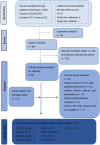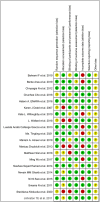Which gait training intervention can most effectively improve gait ability in patients with cerebral palsy? A systematic review and network meta-analysis
- PMID: 36703638
- PMCID: PMC9871496
- DOI: 10.3389/fneur.2022.1005485
Which gait training intervention can most effectively improve gait ability in patients with cerebral palsy? A systematic review and network meta-analysis
Abstract
Background: A vital objective to treat people with cerebral palsy (CP) is to increase gait velocity and improve gross motor function. This study aimed to evaluate the relative effectiveness of gait training interventions for persons with CP.
Methods: Studies published up to October 26, 2022 were searched from four electronic databases [including Medline (via PubMed), Web of Science, Embase and Cochrane]. Studies with randomized controlled trials (RCTs), people with CP, comparisons of different gait training interventions and outcomes of gait velocity and gross motor function measures (GMFM) were included in this study. The quality of the literature was evaluated using the risk of bias tool in the Cochrane Handbook, the extracted data were analyzed through network meta-analysis (NMA) using Stata16.0 and RevMan5.4 software.
Results: Twenty RCTs with a total of 516 individuals with CP were included in accordance with the criteria of this study. The results of the NMA analysis indicated that both external cues treadmill training (ECTT) [mean difference (MD) = 0.10, 95% confidence interval CI (0.04, 0.17), P < 0.05] and partial body weight supported treadmill training (BWSTT) [MD = 0.12, 95% CI (0.01, 0.23), P < 0.05] had better gait velocity than over ground gait training (OGT), BWSTT [MD = 0.09, 95%CI(0.01,0.18), P < 0.05] had a better gait velocity than robot-assisted gait training (RAGT), BWSTT [MD = 0.09, 95% CI (0.06, 0.13) P < 0.05] had a better gait velocity than treadmill training (TT), and BWSTT [MD = 0.14, 95% CI (0.07, 0.21), P < 0.05] had a better gait velocity than conventional physical therapy (CON). The SUCRA ranking indicated that BWSTT optimally improved the gait velocity, and the other followed an order of BWSTT (91.7%) > ECTT (80.9%) > RAGT (46.2%) > TT (44%) > OGT (21.6%) > CON (11.1%). In terms of GMFM, for dimension D (GMFM-D), there was no statistical difference between each comparison; for dimension E (GMFM-E), RAGT [MD = 10.45, 95% CI (2.51, 18.40), P < 0.05] was significantly more effective than CON. Both SUCRA ranking results showed that RAGT improved GMFM-D/E optimally, with rankings of RAGT (69.7%) > TT (69.3%) > BWSTT (67.7%) > OGT (24%) > CON (20.3%), and RAGT (86.1%) > BWSTT (68.2%) > TT (58%) > CON (20.1%) > OGT (17.6%) respectively.
Conclusion: This study suggested that BWSTT was optimal in increasing the gait velocity and RAGT was optimal in optimizing GMFM in persons with CP. Impacted by the limitations of the number and quality of studies, randomized controlled trials with larger sample sizes, multiple centers, and high quality should be conducted to validate the above conclusion. Further studies will be required to focus on the total duration of the intervention, duration and frequency of sessions, and intensity that are optimal for the promotion of gait ability in this population.
Systematic review registration: https://doi.org/10.37766/inplasy2022.10.0108, identifier: INPLASY2022100108.
Keywords: gait; motor skills disorders; randomized controlled trials; rehabilitation; walking speed.
Copyright © 2023 Qian, Cai, Xu, Tian, Meng, Ossowski and Liang.
Conflict of interest statement
The authors declare that the research was conducted in the absence of any commercial or financial relationships that could be construed as a potential conflict of interest.
Figures





Similar articles
-
Systematic review and network meta-analysis of robot-assisted gait training on lower limb function in patients with cerebral palsy.Neurol Sci. 2023 Nov;44(11):3863-3875. doi: 10.1007/s10072-023-06964-w. Epub 2023 Jul 26. Neurol Sci. 2023. PMID: 37495708 Free PMC article. Review.
-
Overground Gait Training With a Wearable Robot in Children With Cerebral Palsy: A Randomized Clinical Trial.JAMA Netw Open. 2024 Jul 1;7(7):e2422625. doi: 10.1001/jamanetworkopen.2024.22625. JAMA Netw Open. 2024. PMID: 39037815 Free PMC article. Clinical Trial.
-
Effect of robot-assisted gait training on motor functions in adolescent and young adult patients with bilateral spastic cerebral palsy: A randomized controlled trial.NeuroRehabilitation. 2020;47(4):495-508. doi: 10.3233/NRE-203102. NeuroRehabilitation. 2020. PMID: 33136072 Clinical Trial.
-
Comparison of a robotic-assisted gait training program with a program of functional gait training for children with cerebral palsy: design and methods of a two group randomized controlled cross-over trial.Springerplus. 2016 Oct 28;5(1):1886. doi: 10.1186/s40064-016-3535-0. eCollection 2016. Springerplus. 2016. PMID: 27843743 Free PMC article.
-
Application of Virtual Reality-Assisted Exergaming on the Rehabilitation of Children with Cerebral Palsy: A Systematic Review and Meta-Analysis.J Clin Med. 2023 Nov 14;12(22):7091. doi: 10.3390/jcm12227091. J Clin Med. 2023. PMID: 38002703 Free PMC article. Review.
Cited by
-
Comparative Effects of Partial Body Weight-Supported and Loaded Treadmill Training on Motor Performance in Children with Cerebral Palsy: A Randomized Clinical Trial.Medicina (Kaunas). 2025 Jun 22;61(7):1125. doi: 10.3390/medicina61071125. Medicina (Kaunas). 2025. PMID: 40731755 Free PMC article. Clinical Trial.
-
Study of the brain function characteristics in children with cerebral palsy during walking using functional near-infrared spectroscopy.Neurophotonics. 2025 Apr;12(2):025004. doi: 10.1117/1.NPh.12.2.025004. Epub 2025 Mar 31. Neurophotonics. 2025. PMID: 40166420 Free PMC article.
-
Robot-assisted gait training improves walking and cerebral connectivity in children with unilateral cerebral palsy.Pediatr Res. 2024 Oct;96(5):1306-1315. doi: 10.1038/s41390-024-03240-1. Epub 2024 May 20. Pediatr Res. 2024. PMID: 38769400 Clinical Trial.
-
Effects of Functional Partial Body Weight Support Treadmill Training on Mobility in Children with Ataxia: A Randomized Controlled Trial.J Funct Morphol Kinesiol. 2025 Apr 6;10(2):123. doi: 10.3390/jfmk10020123. J Funct Morphol Kinesiol. 2025. PMID: 40566420 Free PMC article.
References
-
- World Health Organization . International Classification of Diseases (ICD) [EB/OL]. (2020) Available online at: https://icd.who.int/browse11/l-m/en#/http://id.who.int/icd/entity/76906748 (accessed September 2, 2020).
Publication types
LinkOut - more resources
Full Text Sources
Miscellaneous

